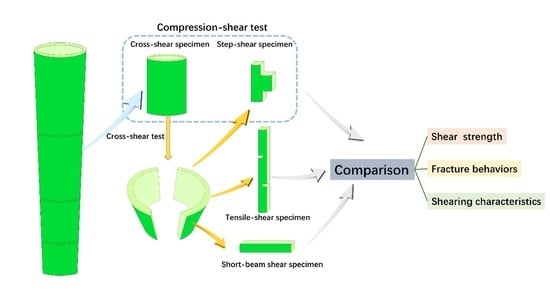Study on Different Shear Performance of Moso Bamboo in Four Test Methods
Abstract
:1. Introduction
2. Materials and Methods
2.1. Materials
2.2. Methods
3. Results and Discussion
3.1. Different Shear Strengths in Four Shear Test Methods
3.2. Fracture Behaviors of Bamboo in Four Test Methods
3.3. Shearing Characteristics and Failure Mechanisms in Four Test Methods
4. Conclusions
Author Contributions
Funding
Institutional Review Board Statement
Informed Consent Statement
Data Availability Statement
Conflicts of Interest
References
- Chen, M.L.; Ye, L.; Li, H.; Wang, G.; Chen, Q.; Fang, C.H.; Dai, C.P.; Fei, B.H. Flexural strength and ductility of moso bamboo. Constr. Build. Mater. 2020, 246, 118418. [Google Scholar] [CrossRef]
- Wang, X.; Keplinger, T.; Gierlinger, N.; Burgert, I. Plant material features responsible for bamboo’s excellent mechanical performance: A comparison of tensile properties of bamboo and spruce at the tissue, fiber and cell wall levels. Ann. Bot. 2014, 114, 1627–1635. [Google Scholar] [CrossRef] [PubMed]
- Manandhar, R.; Kim, J.H.; Kim, J.T. Environmental, social and economic sustainability of bamboo and bamboo-based construction materials in buildings. J. Asian Archit. Build. Eng. 2019, 18, 49–59. [Google Scholar] [CrossRef]
- Li, J.; Ma, R.; Lu, Y.; Wu, Z.; Liu, R.; Su, M.; Jin, X.; Zhang, R.; Bao, Y.; Chen, Y.; et al. Bamboo-inspired design of a stable and high-efficiency catalytic capillary microreactor for nitroaromatics reduction. Appl. Catal. B Environ. 2022, 310, 121297. [Google Scholar] [CrossRef]
- Trujillo, D. Bamboo structures in Colombia. Struct. Eng. 2007, 85, 25–30. [Google Scholar]
- Tang, T.K.H.; Welling, J.; Liese, W. Kiln drying for bamboo culm parts of the species Bambusa stenostachya, Dendrocalamus asper and Thyrsostachys siamensis. J. Indian Acad. Wood Sci. 2013, 10, 26–31. [Google Scholar] [CrossRef]
- Habibi, M.K.; Lu, Y. Crack propagation in bamboo’s hierarchical cellular structure. Sci. Rep. 2014, 4, 1–7. [Google Scholar] [CrossRef] [PubMed] [Green Version]
- Liese, W.; Köhl, M. (Eds.) Bamboo: The Plant and Its Uses; Springer: Berlin/Heidelberg, Germany, 2015. [Google Scholar]
- Arce-Villalobos, O.A. Fundamentals of the Design of Bamboo Structures. Ph.D. Thesis, Technische Universiteit Eindhoven, Eindhoven, The Netherlands, 1993. [Google Scholar]
- Janssen, J.J. Designing and building with bamboo. Neth. Int. Netw. Bamboo Ratt. 2000, 8, 130–133. [Google Scholar]
- Wang, Z.H. The Study on Variability in Bamboo Timber Properties and Relationship with Its Processing. Ph.D. Thesis, Chinese Academy of Forestry, Beijing, China, 2001. [Google Scholar]
- Bautista, B.E.; Garciano, L.E.; Lopez, L.F. Comparative Analysis of Shear Strength Parallel to Fiber of Different Local Bamboo Species in the Philippines. Sustainability 2021, 13, 8164. [Google Scholar] [CrossRef]
- Liese, W.; Weiner, G. Ageing of bamboo culms. A review. Wood Sci. Technol. 1996, 30, 77–89. [Google Scholar] [CrossRef]
- Chen, G.J. The Interspecific Difference of Bamboo Mechanical Properties and Its Influencing Factors. Master’s Thesis, Chinese Academy of Forestry, Beijing, China, 2019. [Google Scholar]
- Gao, L.; Wang, Z.; Lin, T.; Cheng, H.T. Influence of test methods on moso bamboo shear strength parallel to grain. China Wood Ind. 2012, 26, 48–54. [Google Scholar]
- Diao, Q.Q. Specific Modulus Grade of Dimension Bamboo Strips and Manufacture and Evaluation of Bamboo Lamination. Master’s Thesis, Chinese Academy of Forestry, Beijing, China, 2018. [Google Scholar]
- Song, G.N. Design, Manufacture and Evaluation of Graded Glued Bamboo Lamination for Marine Use. Master’s Thesis, Chinese Academy of Forestry, Beijing, China, 2016. [Google Scholar]
- Li, J.; Sun, Z.J. Effects of anisotropy and radial gradient variation on tensile shear strength of Moso bamboo. J. Cent. South Univ. For. Technol. 2013, 33, 120–123. [Google Scholar]
- Zhang, W.F. Mechanical Properties and Brooming Processing of Bamboo-Culm. Master’s Thesis, Chinese Academy of Forestry, Beijing, China, 2012. [Google Scholar]
- Liu, H.R.; Jiang, Z.H.; Fei, B.H.; Hse, C.Y.; Sun, Z.J. Tensile behaviuor and fracture mechanism of moso bamboo (Phyllostachys pubescens). Holzforschung 2015, 69, 47–52. [Google Scholar] [CrossRef]
- Zhang, X.X.; Li, J.H.; Yu, Z.X.; Yu, Y.; Wang, H.K. Compressive failure mechanism and buckling analysis of the graded hierarchical bamboo structure. J. Mater. Sci. 2017, 52, 6999–7007. [Google Scholar] [CrossRef]
- Liu, H.R.; Wang, X.Q.; Zhang, X.B.; Sun, Z.J.; Jiang, Z.H. In situ detection of the fracture behaviour of moso bamboo (Phyllostachys pubescens) by scanning electron microscopy. Holzforschung 2016, 70, 1183–1190. [Google Scholar] [CrossRef]
- Wang, X.; Zhang, S.; Chen, L.; Huang, B.; Fang, C.; Ma, X.; Liu, H.; Sun, F.; Fei, B. Effects of pith ring on the hygroscopicity and dimensional stability of bamboo. Ind. Crops Prod. 2022, 184, 115027. [Google Scholar] [CrossRef]

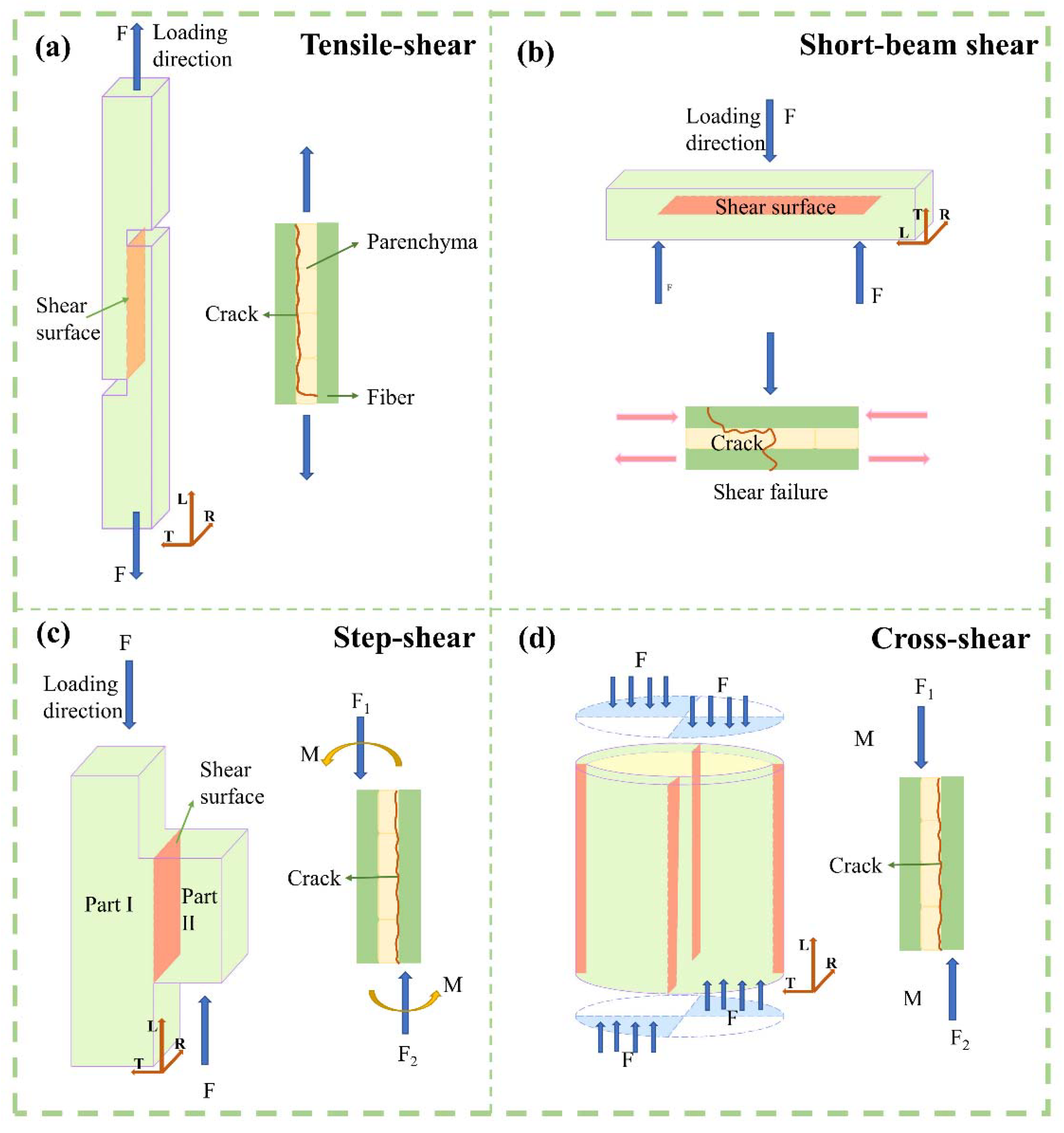


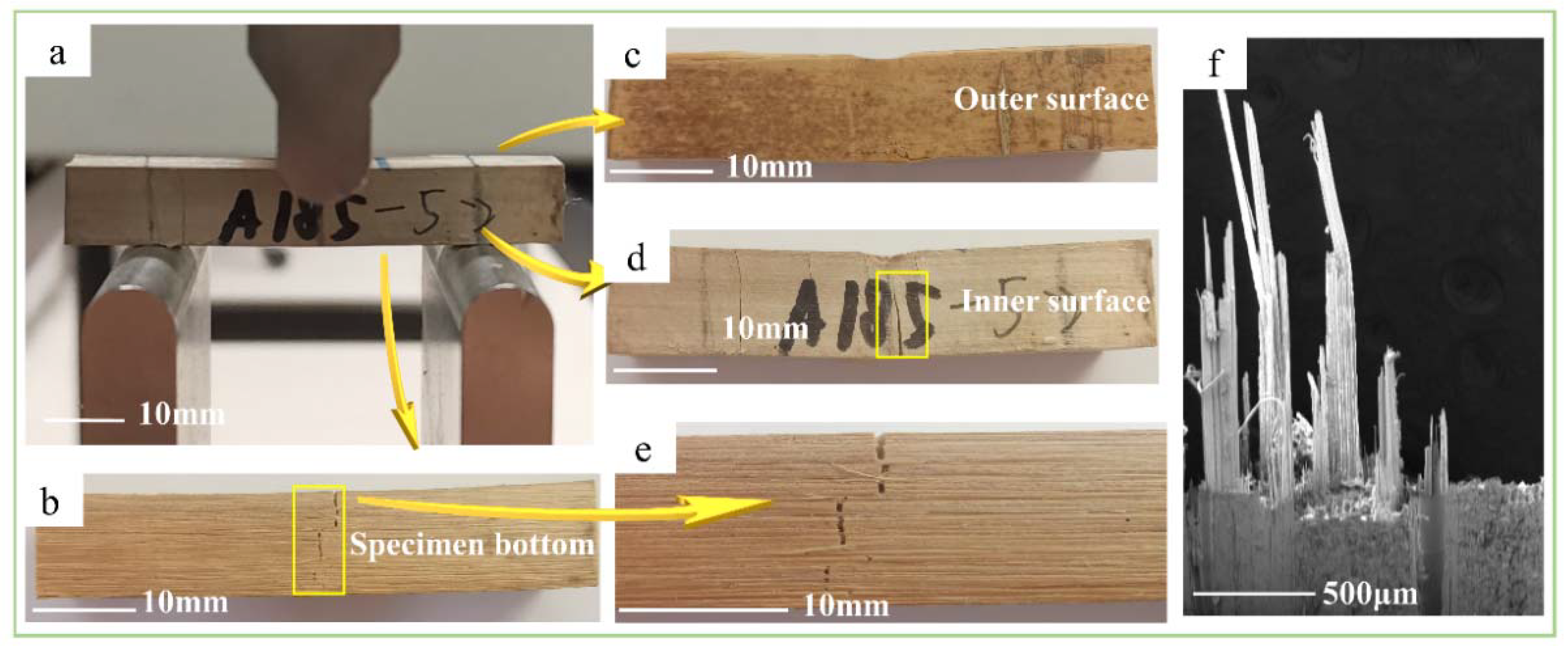
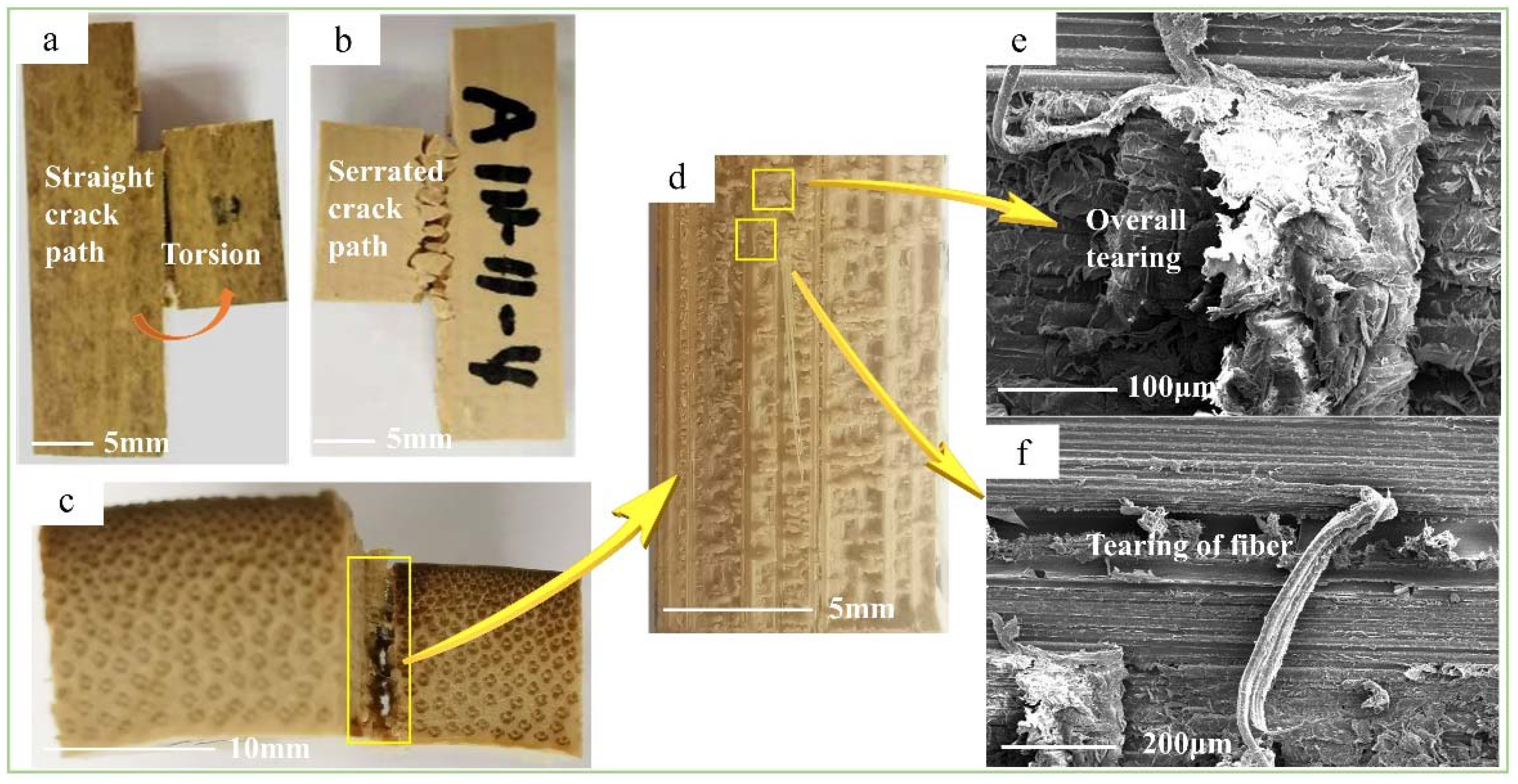

| Test Methods | Reference Standards | Quantity | Specimen Shape and Dimensions (mm) | Test Setup |
|---|---|---|---|---|
| Tensile-shear | ASTM D906 (Standard Test Method for Strength Properties of Adhesives in Plywood Type Construction in Shear by Tension Loading) | 40 |  | 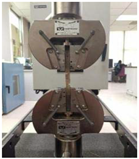 |
| Short-beam shear | ASTM D2344/2344M-2016 (Standard Test Method for Short-Beam Strength of Polymer Matrix Composite Materials and Their Laminates) | 40 |  | 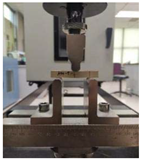 |
| Step-shear | GB/T 15780-1995 (Testing methods for physical and mechanical properties of bamboos) | 60 | 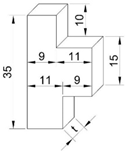 |  |
| Cross-shear | ISO/TR 22157-2-2004 (Bamboo—De-termination of physical and mechanical properties—Part 2: Labora-tory manual) | 10 | 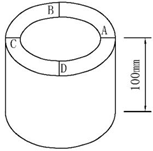 | 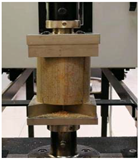 |
Publisher’s Note: MDPI stays neutral with regard to jurisdictional claims in published maps and institutional affiliations. |
© 2022 by the authors. Licensee MDPI, Basel, Switzerland. This article is an open access article distributed under the terms and conditions of the Creative Commons Attribution (CC BY) license (https://creativecommons.org/licenses/by/4.0/).
Share and Cite
Huang, A.; Su, Q.; Zong, Y.; Chen, X.; Liu, H. Study on Different Shear Performance of Moso Bamboo in Four Test Methods. Polymers 2022, 14, 2649. https://doi.org/10.3390/polym14132649
Huang A, Su Q, Zong Y, Chen X, Liu H. Study on Different Shear Performance of Moso Bamboo in Four Test Methods. Polymers. 2022; 14(13):2649. https://doi.org/10.3390/polym14132649
Chicago/Turabian StyleHuang, Aiyue, Qin Su, Yurong Zong, Xiaohan Chen, and Huanrong Liu. 2022. "Study on Different Shear Performance of Moso Bamboo in Four Test Methods" Polymers 14, no. 13: 2649. https://doi.org/10.3390/polym14132649
APA StyleHuang, A., Su, Q., Zong, Y., Chen, X., & Liu, H. (2022). Study on Different Shear Performance of Moso Bamboo in Four Test Methods. Polymers, 14(13), 2649. https://doi.org/10.3390/polym14132649





